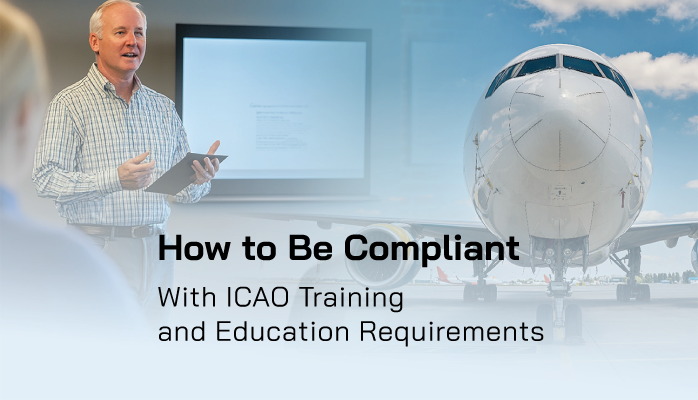ICAO Requirements for Training and Education

ICAO’s requirements for training and education are largely focused on ensuring that you train and document all employees in your organization on core SMS and safety information. It is specific in its guidance documentation that role-based training is important. It also recommends that you have specific training for different tiers in your organization.
The requirements are listed as such:
- 1.1 The service provider shall develop and maintain a safety training program that ensures that personnel is trained and competent to perform their SMS duties.
- 1.2 The scope of the safety training program shall be appropriate to each individual’s involvement in the SMS.
These requirements are rather broad, so ICAO provides quite a bit more documentation drilling into the specifics of what it recommends having a compliant, quality training and education program.
Let’s look at each of these points of guidance.
(5.3.86) Train on Current SMS Information
ICAO points out first and foremost the most significant aspects of your SMS and safety that employees should be trained on. These include:
- Your organizational safety policies, goals, and objectives;
- Your organizational safety roles and responsibilities;
- Basic risk management principles;
- Your safety reporting system;
- Lines of communication (i.e., safety org chart);
- Your validation process for measuring the effectiveness of training; and
- Initial induction and recurring training requirements.
These requirements can largely be met in your initial and recurrent training processes. In initial and recurrent training, you should address these elements. For example, your initial training requirements might require employees to:
- Watch a video discussing how to use the hazard reporting system;
- Direct employees to relevant sections of your Safety Policy, such as:
- Policies
- Procedures
- Safety org chart
- Take a hazard and risk quiz; and
- Take a quiz on their duties and responsibilities.
Quizzes are a good way to validate that employees have read and understand relevant safety information.
(5.3.87) How ICAO Says to Document Training
Your training requirements should reflect the needs and complexity of your organization. Training requirements should be documented for each of your systems, such as:
- Flight Ops;
- Ground Ops; and
- Maintenance.
This is because different systems have entirely different activities and operations.
ICAO says that you track training for each employee, such as by having a training “file” for each employee. A “file” can be:
- Physical;
- Digital; or
- Simply the ability to filter data for specific people in aviation safety software.
Training documentation should span the entirety of your organization, from front-line employees to your accountable executive.
Related Aviation Safety Practices Articles
- Best Ways to Automate Initial/Recurring Training
- Signs of Good Risk Management Training
- Tips to Improve SMS Training
(5.3.88) Ensuring Personnel Are Competent to Perform Safely

What’s extremely important about safety training is that you validate that the training is actually working. By “working” we mean that safety information is:
- Understood by employees; and
- Remembered by employees.
We advocate quizzes as a good way to validate the effectiveness of training. For one, you can set pass/fail grades on quizzes for specific training regimens. Also, it gives you a quantifiable number to measure training effectiveness for:
- Individual employees;
- Specific training regimens;
- Specific roles in your company; and
- The entire company as a whole.
In other words, quizzes create a data collection process out of your training – data that you can filter and analyze in unique ways. Your training documentation needs to outline your validation processes, as well as who is responsible for creating specific content and validation.
(5.3.89) Content to Include in Safety Training for All Employees
ICAO reinforces some of the content it mentions in 5.3.86, making it clear that there are specific aspects of your SMS that are absolutely essential to safety:
- Hazard reporting system;
- Roles and responsibilities;
- Safety Policy; and
- Important Safety Risk Management and Safety Assurance principles, such as continuous improvement and SRM process.
(5.3.90) Content to Include in Safety Training for Top Managers
Furthermore, 5.3.90 specifically brings up that it is a good idea to train top managers with specific training regimens, such as:
- Regulatory compliance information;
- Allocation of resources;
- Budgets;
- How the SMS will be/is promoted; and
- Safety performance targets (SPIs/KPIs).
(5.3.91) Content to Include in Safety Training for Accountable Executive
Lastly, ICAO recommends (not required) that you have special training for the accountable executive, which is more closely related to:
- Training on the performance of the SMS and its integration with the company; then
- On safety principles, concepts, etc.
This training should be “high level,” outlining the broad, organization-wide context of the SMS.
Last updated December 2024.






